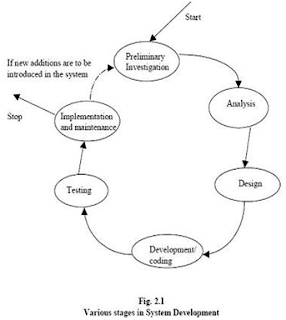The SDLC method is classically thought of as a
set of activities that analysts, designers and users carry out to develop and
implement an information system. There are six activities that make up the
Systems Development Life Cycle.

- Preliminary Investigation
- Determination of system requirements
- Design of system
- Development of software
- System Testing
- Implementation and evaluation
Preliminary
Investigation
When a request is made to receive
assistance from information system , the first systems activity, preliminary
investigation begins. This activity has three parts.
Request Clarification
Many requests from employees and users in organizations are not clearly stated. Therefore, before any systems investigation can be considered, the project request must be examined to determine precisely what the originator wants.
Feasibility Study
An important outcome of the preliminary investigation is the determination that the system requested is feasible. There are three aspects in the feasibility study.
Technical Feasibility
Can the work for the project be done with current equipment, existing software technology and available personnel?
If new technology is required, what is the likely hood that it can be developed?
Economic Feasibility
Are there sufficient benefits in creating the system to make the cost acceptable?
Are the costs of not creating the system so great that the project must be undertaken?
Operational Feasibility
Will the system be used if it is developed and implemented?
Will there be resistance from the users that will undermine the possible application benefits?
Request Approval
Not all requested projects are desirable or feasible. Some organizations receive so many project requests from employees that only a few of them can be perceived. However, those projects that are both feasible and desirable should be put in a schedule.
Determination
of System Requirements
At the heart of the systems analysis
is the detailed understanding of all important faces of the business area under
investigation. Analyst, working closely with employees and managers must study
the business process to answer these key questions.
- What is being done?
- How is it being done?
- How frequently does it occur?
- How great is the volume of transactions or decisions?
- How well is the task being performed?
- Does a problem exist?
- If a problem exists how serious is it?
- If a problem exist what is the underlying cause?
To answer these questions, system
analyst, talk to a variety of persons to gather details about the business
process. Questionnaires are used to collect this information from large groups
of people who cannot be interviewed individually. As the details are gathered,
the analysts study the requirements, data to identify features the new system
should have.
Design
of System
The design of an information system
produces the details that state how a system will meet the requirements
identified during system analysis. System’s specialist often refers to this
stage as logical design, in contrast to the process of developing program
software, which is referred to as physical design. Systems analyst begins the
design process by identifying reports and other outputs the system will
produce. The system design also describes the data to be input, calculated or
stored. Individual data items and calculation procedures are written in detail.
Designers select file structures and storage devices. The documents containing
the design specifications portray the design in many different ways charts,
tables and special sysmbols.
Designers are responsible for
providing programmers with complete and clearly outlined s/w specifications.
Development
of Software
S/w developers may install purchased
software or they may write new, custom designed programs. The choice depends on
the cost of each option, the time available to write s/w and the availability
of programmers. Programmers are also responsible for documenting the program.
Documentation is essential to test the program and carry on maintenance once
the application has been installed.
Systems
Testing
During systems testing, the system is
used experimentally to ensure that the software does not fail. Special test
data are input for processing and the results examined. A limited number of
users may be allowed to use the system so analyst can see whether they try to
use it in unforeseen ways.
Implementation
and Evaluation
Implementation is the process of
having systems personnel check out and put new equipment into use, train users,
install the new application and construct any files of data needed to use it.
Depending on the size of the organization that will be involved in using the
application and the risk associated with it’s use. Systems developers may
choose to pilot test the operation in only one area of the firm or with only
one or two persons.
Once installed, applications are often
used for many years. However, both the organization and the users will change,
and the environment will be different over weeks and months. Therefore the
application will undoubtedly have to be maintained, modifications and changes
will be made to the s/w, files or procedures to meet emerging user
requirements.
Evaluation of the system is performed
to identify its strengths and weaknesses. The actual evaluation can occur along
any of the following dimensions.
- Operational Evaluation
- Organizational Impact
- User management assessment

No comments:
Post a Comment
Your comments are very much valuable for us. Thanks for giving your precious time.